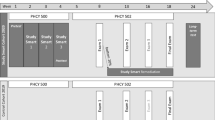Abstract
We are involved in a project to incorporate innovative assessments within a reform-based large-lecture biochemistry course for nonmajors. We not only assessed misconceptions but purposefully changed instruction throughout the semester to confront student ideas. Our research questions targeted student conceptions of deoxyribonucleic acid (DNA) along with understanding in what ways classroom discussions/activities influence student conceptions. Data sources included pre-/post-assessments, semi-structured interviews, and student work on exams/assessments. We found that students held misconceptions about the chemical nature of DNA, with 63 % of students claiming that DNA is alive prior to instruction. The chemical nature of DNA is an important fundamental concept in science fields. We confronted this misconception throughout the semester collecting data from several instructional interventions. Case studies of individual students revealed how various instructional strategies/assessments allowed students to construct and demonstrate the scientifically accepted understanding of the chemical nature of DNA. However, the post-assessment exposed that 40 % of students still held misconceptions about DNA, indicating the persistent nature of this misconception. Implications for teaching and learning are discussed.



Similar content being viewed by others
References
Black, P., & Wiliam, D. (1998). Assessment and classroom learning. Assessment in Education, 5(1), 7–74.
Black, P., & Wiliam, D. (2009). Developing a theory of formative assessment. Educational Assessment, Evaluation and Accountability, 21(1), 5–31.
Concannon, J., Siegel, M. A., Halverson, K. L., & Freyermuth, S. K. (2010). College students’ conceptions of stem cells, stem cell research, and cloning. Journal of Science Education and Technology, 19(2), 177–186.
Gilbert, J. K., & Watts, M. (1983). Conceptions, misconceptions and alternative conceptions. Studies in Science Education, 10, 61–98.
Griffith, F. (1928). The significance of pneumococcal types. Journal of Hygiene, 27(2), 113–159.
Halverson, K. L., Freyermuth, S. K., Siegel, M. A., & Clark, C. (2010). What undergraduates misunderstand about stem cell research. International Journal of Science Education, 32(17), 2253–2272.
Heady, J. E. (2004). Using pretests and posttests. Teaching tips: innovations in undergraduate science instruction. Arlington: NSTA Press.
Heselmans, M. (2001). Jury out on environmental impact of GM soy. Nature Biotechnology, 19, 700–701.
Hewson, P. W. (1981). A conceptual change approach to learning in science. European Journal of Science Education, 3, 383–396.
Hewson, P. W., & Lemberger, J. (1999). Status and subscribing: a response to Schwitzgebel. Science Education, 8, 507–523.
Lawson, A. E., Alkhoury, S., Benford, R., Clark, B. R., & Falconer, K. A. (2000). What kinds of scientific concepts exist? Concept construction and intellectual development in college biology. Journal of Research in Science Teaching, 37, 996–1018.
Lewis, J., Leach, J., & Wood-Robinson, C. (2000). All in the genes?—young people’s understanding of the nature of genes. Journal of Biological Education, 34, 74–79.
Lincoln, Y. S., & Guba, E. G. (1985). Establishing trustworthiness. In Y. S. Lincoln & E. G. Guba (Eds.), Naturalistic inquiry (pp. 289–331). Newbury Park: Sage.
McHughen, A., & Wager, R. (2010). Popular misconceptions: agricultural biotechnology. New Biotechnology, 27, 724–728.
National Research Council. (2001). Classroom assessment and the national science education standards. Washington, DC: National Academy Press.
National Research Council. (2008). Global challenges and directions for agricultural biotechnology. Washington, DC: National Academy Press.
National Research Council. (2011). A framework for K-12 science education: practices, crosscutting concepts, and core ideas. Washington, DC: National Academies Press.
Patton, M. Q. (2002). Qualitative research & evaluation methods (3rd ed.). Thousand Oaks: Sage.
Posner, G. J., Strike, K. A., Hewson, P. W., & Gertzog, W. A. (1982). Accommodation of a scientific conception: toward a theory of conceptual change. Science Education, 66, 211–227.
Rebello, C. M., Siegel, M. A., Freyermuth S. K., Witzig S. B., & Izci, K. (2012). Development of embedded assessments for learning in biotechnology: Results and design process for dissemination. Biochemistry and Molecular Biology Education, 40(2), 82–88.
Richardson, J. (2005). Concept inventories: Tools for uncovering STEM students’ misconceptions. In: Invention and Impact: Building Excellence in Undergraduate Science, Technology, Engineering and Mathematics (STEM) Education (pp. 19–25). Washington (DC): American Association for the Advancement of Science.
Ruiz-Primo, M. A., & Furtak, E. M. (2007). Exploring teachers’ informal formative assessment practices and students’ understanding in the context of scientific inquiry. Journal of Research in Science Teaching, 44(1), 57–84.
Scott, P., Asoko, H., & Leach, J. (2007). Student conceptions and conceptual learning in science. In S. K. Abell & N. G. Lederman (Eds.), Handbook of research on science education (pp. 31–56). Mahwah: Lawrence Erlbaum Associates.
Shaw, K. R., Horne, K. V., Zhang, H., & Boughman, J. (2008). Essay contest reveals misconceptions of high school students in genetics contest. Genetics, 178, 1157–1168.
Smith, E. L., Blakeslee, T. D., & Anderson, C. W. (1993). Teaching strategies associated with conceptual change learning in science. Journal of Research in Science Teaching, 30, 111–126.
Witzig, S. B., Rebello, C. M., Siegel, M. A., Freyermuth, S. K., Izci, K., & McClure, B. A. (2011). Building the BIKE: Development and testing of the Biotechnology Instrument for Knowledge Elicitation (BIKE). Proceedings of the Annual Meeting of the National Association for Research in Science Teaching, Orlando, FL.
Yin, R. (2003). Case study research: design and methods (3rd ed.). Thousand Oaks: Sage.
Acknowledgments
The authors would like to thank Jill Maroo for her assistance with the statistical analysis. This material is based on work supported by the National Science Foundation (NSF) under Grant No. 0837021. Any opinions, findings, and conclusions or recommendations expressed in this material are those of the authors and do not necessarily reflect the views of the NSF.
Author information
Authors and Affiliations
Corresponding author
Rights and permissions
About this article
Cite this article
Witzig, S.B., Freyermuth, S.K., Siegel, M.A. et al. Is DNA Alive? A Study of Conceptual Change Through Targeted Instruction. Res Sci Educ 43, 1361–1375 (2013). https://doi.org/10.1007/s11165-012-9311-4
Published:
Issue Date:
DOI: https://doi.org/10.1007/s11165-012-9311-4




